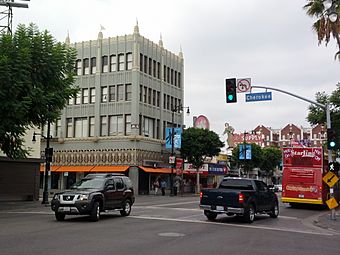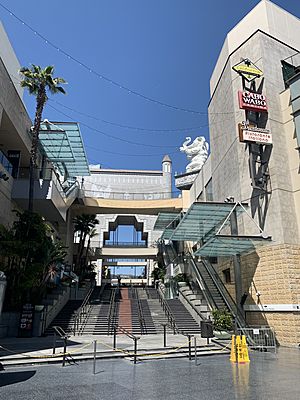Hollywood Boulevard Commercial and Entertainment District facts for kids
Quick facts for kids |
|
|
Hollywood Boulevard Commercial and Entertainment District
|
|
 |
|
| Location | 6200-7000 Hollywood Blvd., N. Vine St., N. Highland Ave. and N. Ivar St., Los Angeles, California |
|---|---|
| Area | 56 acres (23 ha) |
| Built | 1915 |
| Architect | Meyer & Holler; Et al. |
| Architectural style | Late 19th And 20th Century Revivals, Late Victorian, Art Deco |
| NRHP reference No. | 85000704. |
| Added to NRHP | April 4, 1985 |
The Hollywood Boulevard Commercial and Entertainment District is a famous area in Los Angeles, California. It covers twelve blocks of Hollywood Boulevard, from the 6200 to 7000 sections. This special part of Hollywood is known for its history. It was added to the National Register of Historic Places in 1984 because it's so important.
Contents
What Makes This Area Special?
This district is home to some of Hollywood's first movie theaters. Many of these grand movie palaces are still standing today. They were built in the early 1900s. The area has over 100 buildings. These buildings are used for shops, businesses, and entertainment.
The district is located along Hollywood Boulevard in Los Angeles, California. It sits between Argyle Avenue and El Centro Boulevard. This area is famous for its big role in the history of cinema. It had many theaters for the film industry. Plus, it was very close to major movie studios.
Amazing Architecture and Famous Buildings
Even though some buildings have changed, this 12-block area still has many historic landmarks. These buildings show off different architectural styles from the early 1900s. They especially highlight the "Golden Age of Hollywood".
Some of the most famous buildings here are the movie theaters. These include Grauman's Chinese Theatre and Egyptian Theatre. Both of these theaters have a unique Exotic Revival style.
Other cool styles you can see include the Italian Renaissance Revival style. The Hollywood Pacific Theatre building, built in 1928, is a great example. You'll also see the colorful Art Deco style. The Newbury building and the famous Pantages Theater show off this look. The Pantages Theater was built in 1930. It was one of the last big movie palaces built in Hollywood. It still has its original stone look and cool metal details.
The Equitable Building of Hollywood is another important building. It was built in 1929. It mixes Gothic Revival and Art Deco styles. It is a Los Angeles Historic-Cultural Monument. The Hollywood Theatre building was special because it had the country's first neon-lit, triangular sign. This was a big deal when cars became popular in the 1930s.
More Architectural Styles
You can also find Classical Revival and Spanish Colonial Revival styles here. The area changed from a quiet neighborhood to a busy entertainment hub. It has always had a mix of shops, businesses, and, most importantly, theaters.
Buildings like the Taft Building, the Guaranty Building, and the Hollywood Masonic Temple show the Classical Revival style. These are often found at major intersections like Hollywood Blvd/Cahuenga and Hollywood Blvd/Highland. The El Capitan Theater has a beautiful Spanish Baroque style.
You can also spot the French Chatauesque style on smaller shops. The Hollywood Pacific Theater also shows the Italianate beaux style. Many famous architects helped design these buildings. Some names include Walker and Eisen and Meyer and Holler.
Another unique feature is the original Hollywood Metropolitan street lights. These lights were made just for Hollywood. They line the district's part of the Hollywood Walk of Fame.
A Look Back: How Hollywood Boulevard Began
Hollywood Boulevard was first called Prospect Avenue. A miner named John Bower bought land here in 1872. He named the street. Later, Daeida and Harvey Wilcox bought his land in the 1880s. Around 1900, Prospect Avenue was just a small dirt road. It was surrounded by lemon orchards and vegetable fields.
Some buildings started to appear. The Sackett Hotel was a three-story bed and breakfast. It also had the city's first post office. For a while, it was the tallest building in the area. The Hollywood Memorial Church stood at Prospect and Vine from 1903 to 1923. The first Hollywood Hotel opened in 1902. It was a popular spot for silent movie stars. Today, the Hollywood and Highland shopping center is there. This includes the Dolby Theater, where the Academy Awards are held.
In 1904, gas meters were installed, which helped with street numbers. Hollywood became part of Los Angeles in 1910. On January 5, 1910, Prospect Avenue was officially renamed Hollywood Boulevard.
The Golden Age of Hollywood Boulevard
Many of the district's famous buildings were built between 1913 and 1935. This was when the film industry grew very fast. People in the film industry moved west. They saw Hollywood's open land as a great place for studios. Charles E. Toberman, a real estate expert, believed Hollywood Boulevard would become an entertainment center.
This time of growth included the opening of The Hollywood Theater in 1913. It is the oldest existing theater in the district. The area also got its first four-story building. It had shops, offices, and apartments. Wright's ice cream store also opened. It was a very popular ice cream chain for many years. The block between Cahuenga and Wilcox became the first fully commercial block on Hollywood Boulevard.
Growing Taller: The 1920s
The 1920s saw taller buildings appear. The city allowed buildings up to 12 stories high. During this time, the Taft Building (Los Angeles) was built. It took the place of the old Hollywood Memorial Church. The Hollywood Athletic Club was on Hollywood and Cahuenga Boulevard. The Hollywood Masonic Temple building opened in 1922. It is now the El Capitan Entertainment Centre. This site was famous for holding the memorial service for film director D.W. Griffith in 1948.
John's Cafe was the first restaurant on the boulevard. It was a favorite spot for Hollywood's movie workers. Charlie Chaplin often visited for hot apple pie. Other popular restaurants followed, like Musso and Frank's. It is the oldest restaurant in Hollywood and is still at 6667 Hollywood Boulevard.
The Montmartre Cafe was the city's first nightclub. Stars like Rudolph Valentino and Joan Crawford visited it. Bing Crosby made his Hollywood debut there. Many more nightclubs opened over the next ten years. Hollywood became a popular place for evening fun.
The Pig 'n Whistle restaurant opened in 1927. It was one of the first places to sell its own brand of souvenirs. They sold menus, coloring books, and paper masks.
Famous Theaters and Hotels
Four of Hollywood's most famous theaters were built during this time. The Warner Hollywood Theater, now Hollywood Pacific Theatre, opened in 1927. It was in a four-story Italian Renaissance building. This theater showed Warner Brothers films, including Casablanca.
Sid Grauman teamed up with C. E. Tolberman to build the first movie palace on the boulevard. Grauman's Egyptian Theatre opened in 1922. The El Capitan Theatre and Chinese Theatre followed in 1926 and 1927. Tolberman also completed the Hollywood Roosevelt Hotel in May 1927. It is still the oldest running hotel in Los Angeles. The largest and last movie palace, the Pantages Theater (Hollywood), opened on June 4, 1930.
Hollywood's investors faced challenges after the stock market crash of 1929. Many shops closed. Plans for new buildings were stopped. However, the film industry remained strong. It continued to attract tourists and new actors. In the early 1930s, architect S. Charles Lee updated many of the street's buildings. Merchants tried to attract customers by offering "Dollar Days in Hollywood." They called their street the "World's Largest Department Store." Shops used their closeness to Hollywood stars to bring in customers.
Today, this part of Hollywood Boulevard is still a top shopping spot. The Hollywood and Highland Center has many restaurants and shops. It also has a movie theater and the Loews Hollywood hotel. The Academy Awards returned to Hollywood with the $94-million Kodak Theatre project. This theater was designed just for the annual show. It was renamed the Dolby Theater in 2012. It also hosts other live shows.
The Hollywood and Vine intersection now includes the W Hollywood Hotel. Like many blocks in this district, it has street-level dining. Hundreds of homes and offices are on the floors above.
Images for kids






